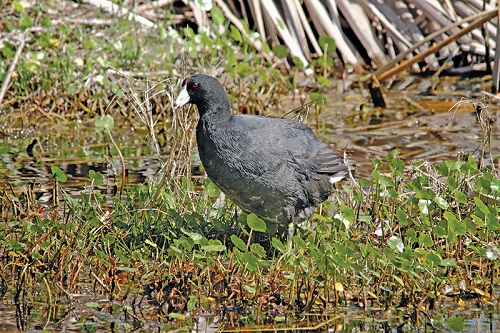 A crisp morning breeze turned the waters of Tubby Cove into a corrugated surface of sparkling silver. We had arrived early and found hundreds of geese, ducks and swans loafing in the morning sun. Tundra swans looked regal with their brilliant white bodies and elegant long necks. Just in front of them a group of birds looked like their opposites, bobbing like big dark balls with strange ivory bills and foreheads.
A crisp morning breeze turned the waters of Tubby Cove into a corrugated surface of sparkling silver. We had arrived early and found hundreds of geese, ducks and swans loafing in the morning sun. Tundra swans looked regal with their brilliant white bodies and elegant long necks. Just in front of them a group of birds looked like their opposites, bobbing like big dark balls with strange ivory bills and foreheads.

There were nine of them, the first arrivals from their nesting areas in Canada.
The odd birds weren’t ducks; they were American coots (Fulica americana). Although they were keeping close company with the far more numerous northern pintails, gadwalls and black ducks, coots are more closely related to rails and other marsh birds like moorhens.
Coots look like a cross between a chicken and a duck. The bill is conical, not flattened. The plump round body is nothing like the sleek lines of most ducks. They don’t have webbed feet. With their fat bodies, skinny legs and outsized feet, coots look a bit like somber clowns when on land. When swimming and diving, though, they are surprisingly graceful.
Male and female coots look alike, although males are slightly larger. The head and neck are black while the wings and body are dark gray. As we peered through our binoculars, we could see their red eyes. The white bill extends up the forehead where it ends with a reddish brown dot. The tip of the bill has an incomplete ring of the same russet color.
Coots have greenish yellow legs and broad lobes on their toes. They use their weird lobed toes to propel themselves, much like ducks use their webbed feet. The lobes can also help a coot walk on the muddy flats near shore. When on solid ground, the lobes fold back with each step, allowing the bird to walk, not waddle, unimpeded.
Tubby Cove is a favorite spot for birders at Eastern Neck Wildlife Refuge on Maryland’s Eastern Shore. The refuge, just north of the Bay Bridge, covers 2,285 acres. With plenty of fields, forests, marshes and open water, it is a haven for thousands of wintering waterfowl.
It is a perfect habitat for coots. They congregate on open water at night to protect themselves from land predators, such as foxes and coyotes. During the day, they can take advantage of the various habitats at the refuge for feeding.
Coots primarily eat plants. They can dive for underwater plants like eelgrass or skim the surface for duckweed and wild rice. On shore, they feast on grass, grains and even tree leaves.
They are not strictly vegetarian, eating insects and the like. During the breeding season, when they are in need of protein, they will also eat tadpoles and salamanders, food that is generally not available during the winter.
Coots prefer fresh or slightly brackish waters. In the Chesapeake, that means they are more likely to be seen near the mouth of rivers than out in the salty waters of the Bay south of the Potomac.
Coots can be found throughout almost all of North America.
They winter in the mid-Atlantic and the U.S. South. There is a permanent population along the Pacific Coast from Alaska down to California, and then in a wide swath across to Missouri and down through Mexico. Migratory coots breed in the central United States and Canada.
Add in areas covered during migration, and virtually all of the continent is covered.
The only other coot species in this hemisphere is the Andean coot, which is strictly a South American species.
Although they are expert swimmers, coots have short wings and are rather clumsy fliers. It can take them weeks to wander down from Canada, staying ahead of frozen waters. We will continue to see new arrivals in the Chesapeake well into January.
With their plump bodies and narrow wings, it is hard for coots to get airborne. On the water, they dash along on the surface until they get enough speed for liftoff.
I thought that coots would be prime targets for hunters, but I was wrong. In Maryland, regulations limit hunters to a total of six ducks a day, with some species like black ducks limited to one per day during hunting season. The limit on coots, in contrast, is 15 per day. In spite of the large limit, coots remain abundant throughout their Chesapeake range and across the continent. Most hunters won’t shoot them because their meat tastes bad.
I thought, sometimes it pays to be a foul-tasting fowl. I smiled at my little pun, then thought more seriously about these avian oddballs. They looked funny, were awkward and weren’t attractive to hunters.
But like many humans outsiders, they were managing to get by in their own way. Out on Tubby’s Cove, they fit right in.
